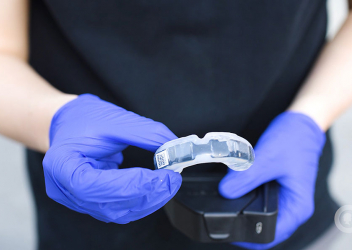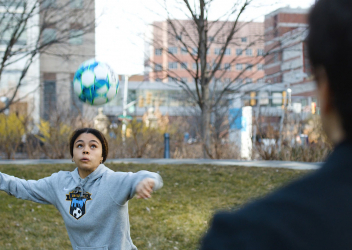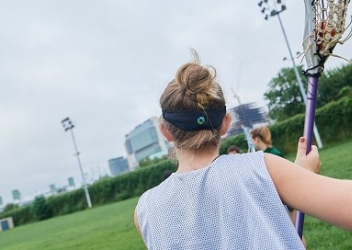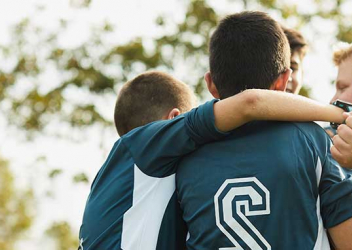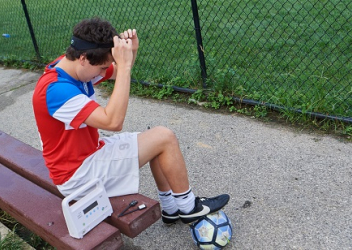Repetitive Head Impacts Via Sensors Research
Approximately 1 in 5 high school athletes who plays a contact sport – such as soccer, lacrosse, and American football – suffers a concussion each year. To understand the frequency, magnitude and direction of head impacts that athletes sustain, a wide variety of sensors have been developed to collect head impact biomechanics data, including instrumented helmets, skull caps, headbands, mouth guards and skin patches.
In the Objective Translational Multi-Domain Early Concussion Assessment Study, researchers are deploying head impact sensors to quantify biomechanical load exposure by sport and sex, and relationships between load exposure and neuro-functional metrics. Integrated with other research aims and methods, research using head impact sensors will provide new knowledge regarding high-risk biomechanical settings for the young brain.
Research Projects
- Estimating and Measuring Head Impact Exposure On-Field
Currently, the Minds Matter research team is analyzing head impact exposures in youth sports using head impact sensors.
Variations in Head Impact Rates in Male and Female High School Soccer
Non-Header Impact Exposure and Kinematics of Male Youth Soccer Players
Quantifying Head Impact Exposure, Mechanisms and Kinematics Using Instrumented Mouthguards in Female High School Lacrosse
A female high school varsity lacrosse team wore the Stanford Instrumented Mouthguard during competitive games for the 2019 season. Researchers note the most common head impact site was the side of the head (35.5%), followed by the face/jaw (25.8%), forehead (6.5%), and crown (6.5%). Impacts to the face/jaw region of the head had significantly (p < 0.05) greater peak kinematics compared to other regions of the head. Stick impacts represented over half of the impact sustained and were associated with the highest kinematics. The current study provides initial data regarding the frequency, magnitude and site of impacts sustained in female high school lacrosse. A larger sample size of high quality head impact data in female lacrosse is required to confirm these findings.
Sport- and Gender-Based Differences in Head Impact Exposure and Mechanism in High School Sports
In this study, researchers utilized headband-mounted impact sensors to identify sport and gender differences in high school soccer, basketball, lacrosse, and field hockey (girls only). Video review was used to remove false-positive sensor-recorded events. Researchers found that soccer had the highest head impact rates for both genders and boys had significantly higher head impact rates for soccer, basketball, and lacrosse than girls. For girls, basketball had higher impact rates than lacrosse and field hockey. These findings enable opportunities to identify sport-specific strategies to reduce repetitive head impacts and lower risk of head injury in sport.
- Evaluating Repetitive Head Impacts in the Laboratory
The Minds Matter research team is determining protocols for head impact sensors and helmet-based kinetic measurement systems that yield high-quality data for research.
Neurophysiological Effects of Repeated Soccer Heading in Youth
The study used instrumented mouthguards to quantify the head kinematics and a comprehensive suite of clinical and physiologial assessments to measure the effects of repetitive soccer headers in teens. Adolescent soccer players in frontal or oblique heading groups completed six neurophysiological assessments immediately prior to, immediately after, and 24 hours after completing 10 headers. They were compared to a control group that performed no headers, only kicks. Testing results found no neurophysiological deficits for heading groups compared to controls. The findings suggest that a bout of repeated headers does not result in any immediate changes across a broad suite of assessments. Limited soccer heading exposure in youth sports may not result in irreversible harm if players are properly trained.
Finite Element Brain Deformation in Adolescent Soccer Heading
This study sought to estimate key biomechanical measures of brain tissue injury as a result of frontal and oblique soccer headers performed by adolescents. Soccer headers were simulated to estimate diffuse brain strains and stresses utilizing the Kungliga Tekniska Högskolan (KTH, Royal Institute of Technology) finite element head model. Brain strain and stress was slightly higher for oblique headers compared to frontal. However, simulations revealed that neither frontal nor oblique headers exceeded injury thresholds, producing a low associated risk of concussion (< 0.5). Data provides insight into repetitive loading effects on the brain and the importance of emphasizing frontal heading techniques.
- Protocols for Using Head Impact SensorsMore
Effect of Filtering Kinematics on Finite Element Simulations of Head Impacts in High School Female Lacrosse
Comparison of Video-Identified Head Contacts and Sensor-Recorded Events in High School Soccer
Video Confirmation of Head Impact Sensors
In this study, researchers collected in vivo head impact biomechanics data on youth athletes. They partnered with the Shipley School, where their athletes were already wearing Triax SIM-G headband-mounted impact sensors during sports competition. While the Triax SIM-G had been validated in a laboratory setting, CHOP researchers found that head impact sensors can record a large number of false positive impacts during real game play in high school competitive soccer games. The extra step to video-confirm the sensor data is essential to minimize false positives before using this data for research and in injury prevention strategies for player safety.
Select Review Publication
Head Impact Sensor Studies In Sports: A Systematic Review Of Exposure Confirmation Methods
This 2020 systematic review analyzes the proportion of published head impact sensor data studies that used confirmation methods to reduce false positives. Based on the 168 articles published over the past two decades that met the inclusion criteria, approximately two-thirds did not use video confirmation for all sensor recorded events. The use of video confirmation is critical in removing false positives and identifying accurate head impact exposure.
- Laboratory Evaluation of Head Impact Sensors
Laboratory Assessment of a Headband-Mounted Sensor for Measurement of Head Impact Rotational Kinematics
Laboratory Assessment of A Head Impact Sensor for Youth Soccer Ball Heading Impacts Using An Anthropomorphic Test Device
Validation of a Helmet-Based System to Measure Head Impact Biomechanics in Ice Hockey
Measurement of Hybrid III Head Impact Kinematics Using an Accelerometer and Gyroscope System in Ice Hockey Helmets
Watch Dr. Kristy Arbogast describe how researchers use smart mouthguard sensors to determine what types of head impacts result in concussion:




